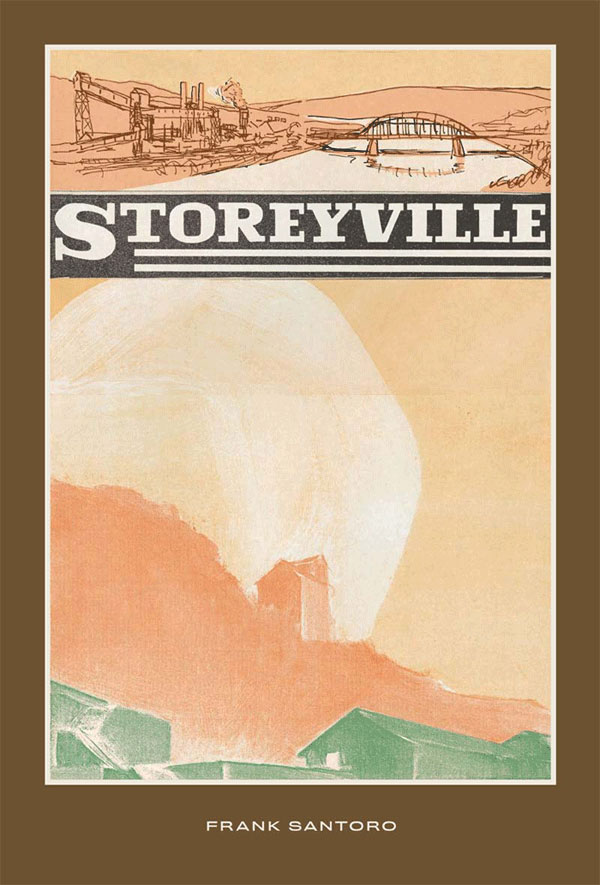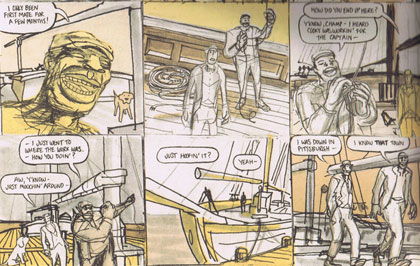 STOREYVILLE by Frank Santoro is published by PictureBox. They are known for their art comics. Some of you might be familiar with two of their most famous books Maggots and Ninja, both by Brian Chippendale. I will admit I don’t really “get” these two books, and most of the other books PictureBox publishes, for that matter. I like to think of myself as an educated reader. I have a degree in art so I like to think I have the proper education to be able to understand and appreciate these works. I want to enjoy these works, but I can’t get past my initial response of “this looks like a bunch of scratchy lines” or “my friends used to draw these flip books in 5th grade.”
STOREYVILLE by Frank Santoro is published by PictureBox. They are known for their art comics. Some of you might be familiar with two of their most famous books Maggots and Ninja, both by Brian Chippendale. I will admit I don’t really “get” these two books, and most of the other books PictureBox publishes, for that matter. I like to think of myself as an educated reader. I have a degree in art so I like to think I have the proper education to be able to understand and appreciate these works. I want to enjoy these works, but I can’t get past my initial response of “this looks like a bunch of scratchy lines” or “my friends used to draw these flip books in 5th grade.”But Storeyville has helped me to get past all my biases. It wasn’t something I had to “get,” it was something I could just enjoy. The art and the format are out of the norm for most of the comics I read. Storeyville isn’t like an issue of Spider-Man or Superman. Generally speaking I read standard sized floppies (or pamphlets, whatever you want to call them), comics that have 32 pages, are 10 inches by 6 3/4 inches, have bright colors and have staples in the middle.
Storeyville is a hardcover collection of issues originally published on newsprint; it is oversized at 11 x 16 inches; and it has a muted color palette mainly consisting of browns, grays and yellows. The one thing that Storeyville has that connects it to standard comics is a linear narrative. Some art comics lack a linear narrative and that can make them extremely difficult to connect to and decipher. Storeyville is an excellent introduction to art comics because you still have a footing in familiar territory.

Storeyville focuses on a grifter named Will and his journey to find his former partner, Reverend Rudy. Will leaves behind his friends in Pittsburgh and travels to Montreal hoping to find Rudy there. The story is delicately paced. It is slow and winding, like Will’s journey. Many of the panels are devoted to mountains, trees, lakes and cityscapes. The journey is as important as the destination.
Along the way we learn why Rudy is so important to Will and why Will is so determined to find Rudy. The rough art style and the color palette make the story feel like a memory or a dream. It feels ephemeral. It is like Will is remembering his journey. All of the events are playing out in his mind years later. The colors are dull and faded. People’s faces are blurry and just out of reach. The storytelling and the art blend perfectly to create a story about how the past stays in the past and can never be regained. It is a story about searching for something and finding yourself.


2 comments:
You nailed it Shawn-- this is a book that everyone should experience.
Terrific review!!
I'd like to posit that no one uses color in comics as effectively as Frank Santoro does in his work. From Storeyville to Cold Heat, I love how Frank uses color in his work.
Glad that you liked this book Shawn, it makes me want to read my copy I got SPX last year.
Post a Comment